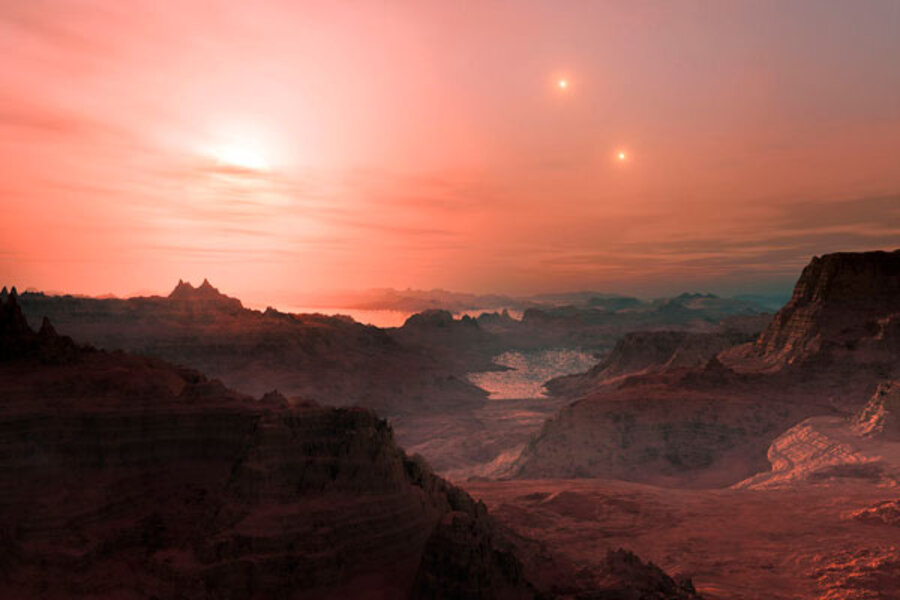Four habitable planets orbiting three tiny suns? New first in planet-hunting.
Loading...
Three, perhaps even four potentially habitable planets are orbiting a star in a triple-star system some 22 light-years from Earth, a team of astronomers announced Tuesday.
It's the first time researchers have found so many planets orbiting within a star's habitable zone – a region around a star where a planet receives enough energy for water to gather and remain stable on the planet's surface.
Three of the planets are so-called super-Earths, with masses ranging from 2.7 to 3.8 times Earth's mass. At 1.1 times Earth's mass, the fourth is the smallest and least well observed of the group – an object that the researchers say will require more observations to determine if it truly orbits in the habitable zone.
It's a packed neighborhood. All four orbit their star, Gliese 667C, in a 11.5-million-mile-wide belt that would comfortably fit within the distance between the orbits of Earth and Venus. In this case, however, the planets' orbits are much closer to their star – a red dwarf with only one-third the sun's mass and perhaps 1 percent of the sun's brightness.
The habitable zones for such faint stars are far closer to the star than is the case in our solar system. The most distant of the four planets orbits Gliese 667C once every 62 days, while the closest of the four orbits once every 16 days.
The team, led by Guillem Anglada-Escudé from the University of Göttingen's Institute for Astrophysics in Germany, had focused its formal report, accepted for publication in the journal Astronomy and Astrophysics, on the three planets representing the most solid detections.
"This is the first time that three such planets have been spotted orbiting in this zone in the same system," said Paul Butler, an astronomer at the Carnegie Institution for Science in Washington and a member of the research team, in a prepared statement.
Indeed, the three are among five to seven planets thought to be orbiting Gliese 667C. Last year, another team of astronomers reported the discovery of three planets orbiting the star. One was located within the star's habitable zone. The evidence for the three was strong, but researchers suspected more planets were lurking in the data the team had gathered from the European Southern Observatory's 3.6-meter telescope at the La Silla Observatory in Chile's Atacama Desert.
Dr. Anglada-Escudé's team added fresh observations to previously gathered data and applied a pair of statistical tools to sift through the data for more planets. Both approaches turned up "five very secure signals and up to seven low-mass planets" in very tight orbits around the star, he said.
For any sentient creatures living on any of the three super Earths, the two other stars in the triple-star system would bathe the the landscape with moon-like light and would remain visible during the day.
But the presence of a landscape, or even seascape – let alone life – on any of these objects remains speculative. The team used an approach to planet-hunting that yields an estimate of a planet's mass and orbital period. The technique involves hunting for the wobble a planet imposes on a star's spectrum as its gravity tugs the star to and fro with each orbit. However, nothing in the technique, known as the radial-velocity approach, gives enough information to estimate a planet's size and bulk density. Density would indicate whether a planet is rocky, mostly gas, or perhaps a water world.
Another approach, which looks for the dimming a planet imparts as it transits in front of its star, can provide the information that would permit density calculations. But none of these planets has been detected via the transit method.
Instead, the team offers speculation informed by what astronomers have been learning about the distribution of planets in other star systems where bulk composition has been determined, as well as what's known about solar-system formation.
The team posits that because the trio of planets is less massive than the lightest known gas planet or the most massive-known rocky planet, it will consider them rocky for the sake of discussion.
Gliese 667C, thought to be substantially older than 2 billion years, appears to lack the outbursts of radiation often seen in red dwarf stars. Astrobiologists have expressed concerns that such outburst could fry organisms on the surface of a planet in the habitable zone.
The planets also appear to be in circular, or nearly circular orbits and so would present the same face to Gliese 667C throughout their orbits. If the planets have thin atmospheres, the day side probably would be too hot and the night side too cold for life – at least on the surface. A thick atmosphere could redistribute heat among both hemispheres, moderating the climate in at least some locations on the surface.
For astrobiologists, finding such a high-density neighborhood around a star so close represents a scientific goldmine as a new generation of space telescopes come on line.
“Instead of observing 10 stars to look for a single potentially habitable planet, we now know we can look at just one star and find several of them,” said Rory Barnes, an astrobiologist and member of the research team reporting the results.





